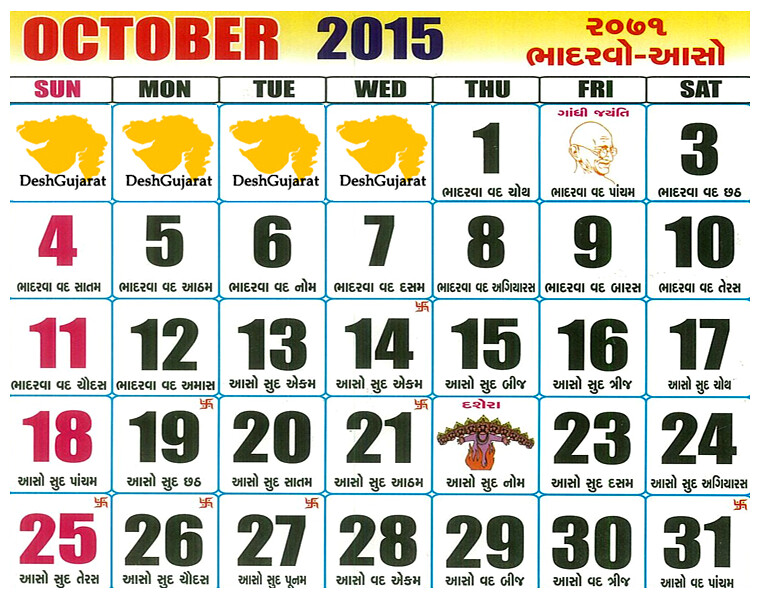Gujarati Calendar 2014 With Tithi Pdf
Gujarati Calendar 2013 : Vikram Samvat Year 2069
January 03, 2013Calendar 2021 gujarati. Calendars online and print friendly for any year and month. Gujarati calendar march 2020 vikram samvat 2076 phaguna hindu calendar 2021 with tithi 19370 thanks for visiting my blog article above hindu calendar 2021 with tithi published by edi suparman at april 6 2020. Gujarati Calendar 2020 for December - This calendar provides you all the details of ચોઘડિયા, દૈનિક પંચાંગ, ગુજરાતી કૅલેન્ડર, Gujarati festivals, holidays, bhadarvi poonam 2020, tithi, gujarati panchang details, tithi toran gujarati calendar, choghadiya timings in Gujarati language. Hindu Calendar.New. Hindu Rituals & Religion; History of Hindu Religion; Solah Sanskar.
Gujarati Calendar 2013: Vikram Samvat Gujarati year of 2069
Gujarati Calendar 2015 – August
Gujarati Calendar 2015 – September
Gujarati Calendar 2015 – October
Gujarati Calendar 2015 – November
Gujarati Calendar 2015 – December
About Gujarati Calendar 2013 and Vikram Samvat
Gujarati Calendar 2019 With Tithi
Gujarati Hindu calendar is part of each Gujarati’s life. While Christian calendar is very much in practice at job/business/professional fronts, when it comes to spirituality or faith, when it comes to fairs and festivals, when it comes to identify auspicious days and holy schedules, Gujarati calendar is followed.

Gujarati calendar begins a day after Diwali. It begins with Gujarati month of kartak followed by Magshar, Posh, Maha, Fagan, Chaitra, Vaishakh, Jeth, Ashadh, Shravan, Bhadarvo and Aaso.

Days in Gujarati calendar are pronounced like this: Monday = Somvar, Tuesday = Mangalvaar, Wednesday = Budhvaar, Thursday = Guruvaar, Friday = Shukravaar, Saturday = Shanivaar and Sunday = Ravivaar.


In general there are three seasons in India which are winter, summer and monsoon. They are respectively called Shiyaalo, Unaalo and Chomaasu in Gujarati language. However there are sub seasons too in each season. They are Vasant(spring), Grishma(summer), Varsha(monsoon), Sharad(autumn), Hemant(pre-winter) and Shishir(winter).
As per the Gujarati calendar, the months of Chaitra and Vaishakh are considered as Vasant or Spring. Similary Jeth and Ashadh are the months of Grishma or Summer. Shravana and Bhadarvo = Varsha or Monsoon. Aso and Kartak = Sharad or Autumn. Magshar and Posh mean Hemant or pre-winter and Maha and Fagan mean Shishir or Winter.

Gujarati Vikram Samvat Calendar is around 56-year ahead of Christian calendar. This means if as per Christian calendar it is year 2012, in Gujarati calendar it would be considered as 2012+56= 2068th year. The Vikrama Samvat lunar calendar was founded by the emperor Vikramaditya of Ujjain following his victory over the Shakas in 56 BCE. (To calculate the present Christian year, 57 years should be subtracted from the Indian year if the date is between starting of the Indian year and the end of the Western year i.e. between Kartak sud 1 and 31 December. If the date falls between the beginning of the Western year and the end of the Indian year i.e. between 1 January and Aso vad 30, then only 56 years should be subtracted.)
Gujarati Vikram Samvat calendar uses a solar year but divides it into 12 lunar months, each consisting 29 days 12 hours 44 minutes and 3 seconds. All together a lunar year of 354 days 8 hours 48 minutes and 36 seconds. To fix the lunar months into the solar year( because 60 solar months = 62 lunar months) there is a practice of adding an extra month which is called Adhik Mahino or Purushottam maas at interval of 30 months or say two and half years. In Gujarati Hindu Vikram Samvat Calendar seasons are as per the sun, months as per the moon and days as per both the sun and the moon.
Lunar days or tithis can have various lengths. Not only this but sometimes a tithi is omitted or sometime two continuous days share the same tithi. This is because in Gujarati Calendar the days are calculated using the difference of the longitudinal angle between the position of the sun and moon.
Difference between Gujarati Vikram Samvat Calendar year and northern Indian Vikram Samvat Calendar year is that while Gujarati Calendar year of Vikram Samvat begins with the first day after the new moon in the month of Kartak( a day after Diwali usually in October/November in popular calendar), in northern Indian parts the same Vikram Samvat calendar starts with the first day after the new moon in the month of Chaitra(usually in March/April in Christian calendar). On the other hand in Nepal where Vikram Samvat is official calendar the new year begins in the middle of April.
Instruction of usage
Currently we are releasing only November 2011-August 2012 calender pages. All the other months pages will be released soon. Your suggestions are welcome.
To download the calender (1) Press right click of your mouse over the image of the page, (2) Select ‘Save Image As’ option, (3) Click over your selection.
To make it as a desktop wallpaper, (1)Press right click of your mouse over the image, (2) Select ‘Set as Desktop background’, (3) Click over your selection.
Related Stories
Recent Stories
Hindu Calendar 2014 with tithi in Hindi PDF Download, Hindi Calendar 2014 PDF download, Printable Hindi calendar 2014 download..
R E L A T E D
Hindu Calendar 2014 in Hindi with tithi PDF download or printable Hindi Panchang cum calendar for year 2014 is here for free. The calendar includes the date, tithi, Ekadasi, Sankashti Chaturthi, Purnima, Amavasya dates, Hindi festivals dates, etc.
Tithi Calendar 2020
This Panchang cum calendar is based on the Purnimant Hindi calendars followed in North Indian states like Jammu & Kashmir, Himachal Pradesh, Haryana, Punjab, Delhi, Uttarakhand, Uttar Pradesh, Bihar, Jharkhand, Madhya Pradesh, Chhattisgarh, etc.
Gujarati Calendar 2014 With Tithi Pdf July
Note: Hindupad reserves all the rights of the ‘Hindu Calendar 2014 in Hindi with Tithi’. Please use it for domestic purposes. Share it with your friends, contacts and social networks.
